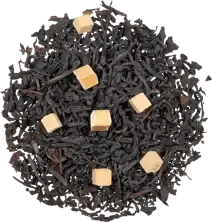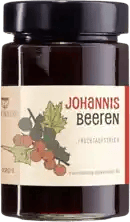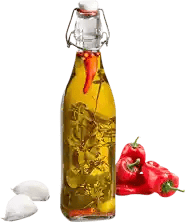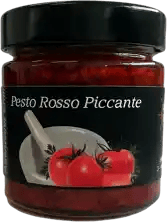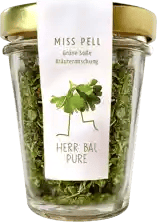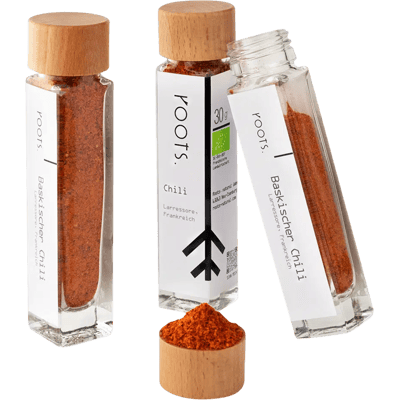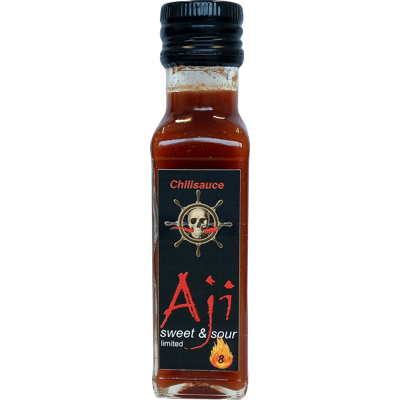Quality instead of quantity!
7,000 independent products
No mainstream
7,000 independent products
The fiery world of chilies: varieties, heat levels and uses

The most important facts summarized for you:
- Chili peppers come in many varieties, from mild to extremely hot.
- The heat level of chili is measured in Scoville units.
- Chillies are rich in vitamins and antioxidants and can provide many health benefits.
- Chili can be used fresh, dried or in powder form.
- Care should be taken when handling hot chilies to avoid skin and eye irritation.
Buy chili products
What is chili?
Chili, also known as chili pepper, is a fruit of the Capsicum plant species and belongs to the nightshade family. The fiery fruits are known for their spiciness, which is caused by the capsaicin they contain. Chilli is used in cooking all over the world to add heat and flavor to dishes.
Different types of chili and their heat level
1. jalapeño
Heat level: 2,500 - 8,000 Scoville units
Taste: Fruity and slightly smoky
Use: Ideal for salsas, toppings on nachos or stuffed as an appetizer.
2. cayenne
Pungency level: 30,000 - 50,000 Scoville units
Taste: Hot and slightly bitter
Use: Often used dried or as a powder, ideal for seasoning dishes or as an ingredient in hot spice blends.
3. habanero
Pungency level: 100,000 - 350,000 Scoville units
Taste: Very hot, with fruity undertones
Use: Perfect for hot sauces, marinades or as a seasoning in soups and stews.
4. bhut jolokia (ghost pepper)
Pungency level: 1,000,000+ Scoville units
Taste: Extremely hot, with fruity notes
Use: For experienced chili lovers only; often used in extremely hot sauces or in very small amounts as a condiment.

The reason for the burning sensation that chili leaves in the mouth lies in the ingredient capsaicin
Why does chili burn on the tongue?
When we eat chilies, we sometimes feel a burning pain on our tongue, as if we have been burned. But why is that?
- Because of the active ingredient capsaicin. This substance irritates the same nerves in the tongue that are also stimulated by eating and drinking too hot. This causes the burning pain without actually heating the tongue.
Use of chili
Chillies are known for their spiciness and enhance many a dish. However, they also offer a number of health benefits. They are rich in vitamins C and A, contain antioxidants and can stimulate the metabolism.
Use in medicine
In medicine, its active ingredient capsaicin is used in medicines for muscle pain, muscle tension, joint pain, rheumatic complaints or as a heat therapy. It can also help to reduce weight.
- Heat patches: The active ingredient generates heat and is often the basic ingredient in heat patches and is used to relax muscles
- Ointments: Capsaicin in ointments, lotions or gels has a warming effect on stressed and painful parts of the body.
- Slimming products: Due to its metabolism-stimulating effect, it is contained in many diet capsules.
Use in the kitchen
Chilli is versatile in the kitchen and can be used fresh, dried or in powder form. Here are some ideas on how you can use chili in your kitchen:
- Fresh chilies: use them in salsas, salads or as a spice in curries and soups. Fresh chillies not only add heat, but also a fruity note to your dishes.
- Dried chillies: Ideal for seasoning stews and stews or for making your own chilli powder. Dried chillies have a concentrated heat and a more intense flavor.
- Chilli powder: An easy way to add heat to any dish. Sprinkle it over meat, vegetables or use it in marinades and sauces.

Always wear gloves when cutting chilies.
Tips for handling chili
- Protection: It is best to wear gloves when working with very hot chilies to avoid skin irritation.
- Be careful with your eyes: Avoid touching your eyes after handling chillies. Capsaicin can cause severe irritation.
- Reduce the heat: If a dish has become too spicy, you can tone down the heat by adding yogurt, cream or sugar.
Conclusion
Chilli is a true all-rounder in the kitchen and offers an incredible variety of flavors and intensities of heat. Whether you like it mild or extremely hot, you can add that certain something to your dishes with chilli. At the same time, you benefit from the health benefits that these little peppers bring with them.
Matching products to the article
Recent articles
-
12 SepWhy refined sugar is bad for you
-
11 SepEverything you need to know about the best-before date (BBD)
-
09 SepPitaya: The secret of the exotic dragon fruit
-
09 SepExotic fruit wines: a look at wines made from exotic fruits
-
09 SepThe world of exotic spices - discover new flavors
-
09 SepThe art of barrel ageing: how different types of wood & barrel sizes influence the taste of spirits
-
09 SepThe world of cinnamon: Ceylon vs. cassia
-
05 SepFermented honey: the comeback of the ancient delicacy
-
05 SepThe perfect ice cube mold: how ice changes the taste of your drinks
Brilliant!

Bitte bestätige deine Anmeldung noch eben - du hast eine Bestätigungsmail von uns. Klicke darin auf den Link. Danach bekommst du deinen Rabattgutschein.


























































